JEEP GRAND CHEROKEE 2013 Owner handbook (in English)
Manufacturer: JEEP, Model Year: 2013, Model line: GRAND CHEROKEE, Model: JEEP GRAND CHEROKEE 2013Pages: 408, PDF Size: 3.21 MB
Page 291 of 408
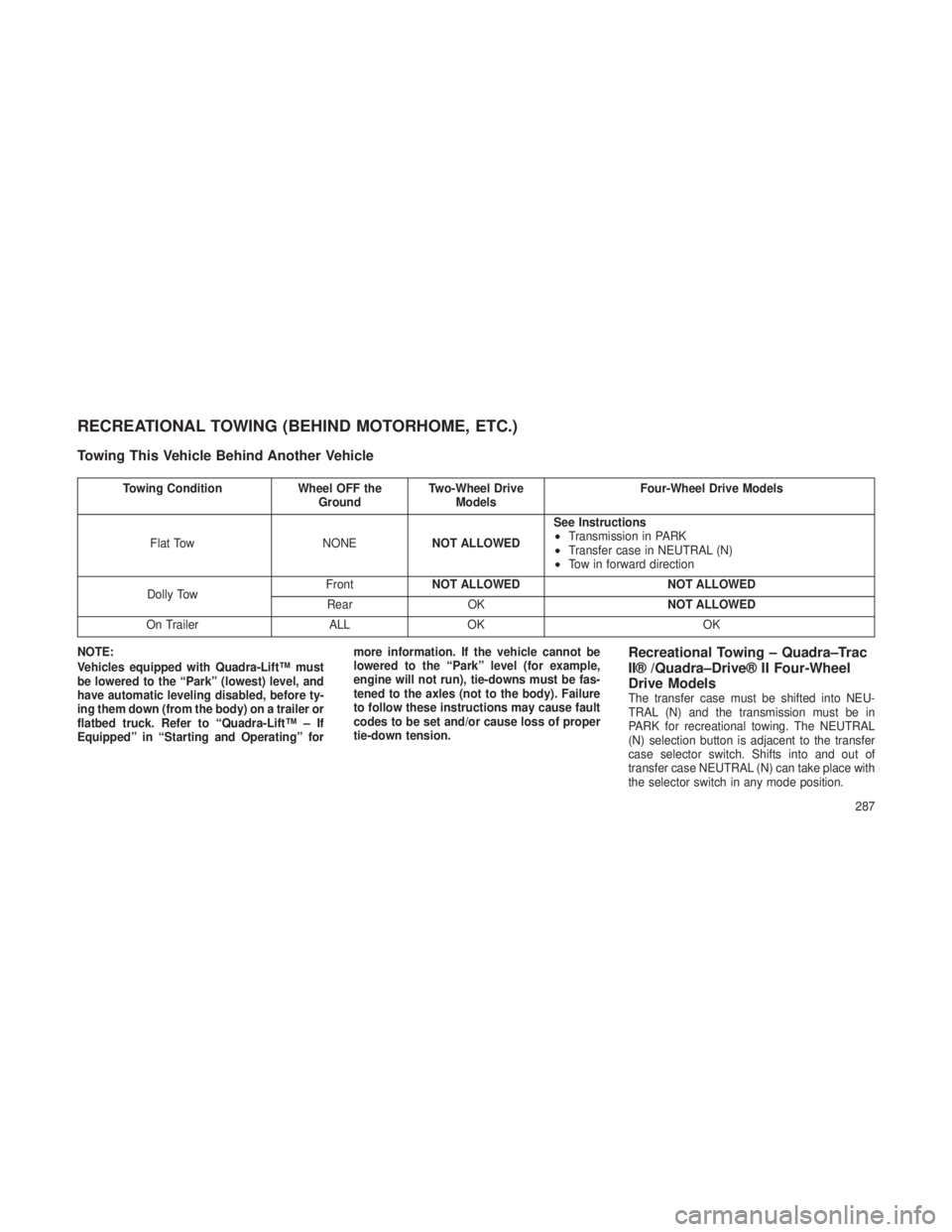
RECREATIONAL TOWING (BEHIND MOTORHOME, ETC.)
Towing This Vehicle Behind Another Vehicle
Towing ConditionWheel OFF the
Ground Two-Wheel Drive
Models Four-Wheel Drive Models
Flat Tow NONENOT ALLOWED See Instructions
•Transmission in PARK•Transfer case in NEUTRAL (N)•Tow in forward direction
Dolly Tow Front
NOT ALLOWED NOT ALLOWED
Rear OK NOT ALLOWED
On Trailer ALLOK OK
NOTE:
Vehicles equipped with Quadra-Lift™ must
be lowered to the “Park” (lowest) level, and
have automatic leveling disabled, before ty-
ing them down (from the body) on a trailer or
flatbed truck. Refer to “Quadra-Lift™ – If
Equipped” in “Starting and Operating” for more information. If the vehicle cannot be
lowered to the “Park” level (for example,
engine will not run), tie-downs must be fas-
tened to the axles (not to the body). Failure
to follow these instructions may cause fault
codes to be set and/or cause loss of proper
tie-down tension.
Recreational Towing – Quadra–Trac
II® /Quadra–Drive® II Four-Wheel
Drive Models
The transfer case must be shifted into NEU-
TRAL (N) and the transmission must be in
PARK for recreational towing. The NEUTRAL
(N) selection button is adjacent to the transfer
case selector switch. Shifts into and out of
transfer case NEUTRAL (N) can take place with
the selector switch in any mode position.
287
Page 292 of 408
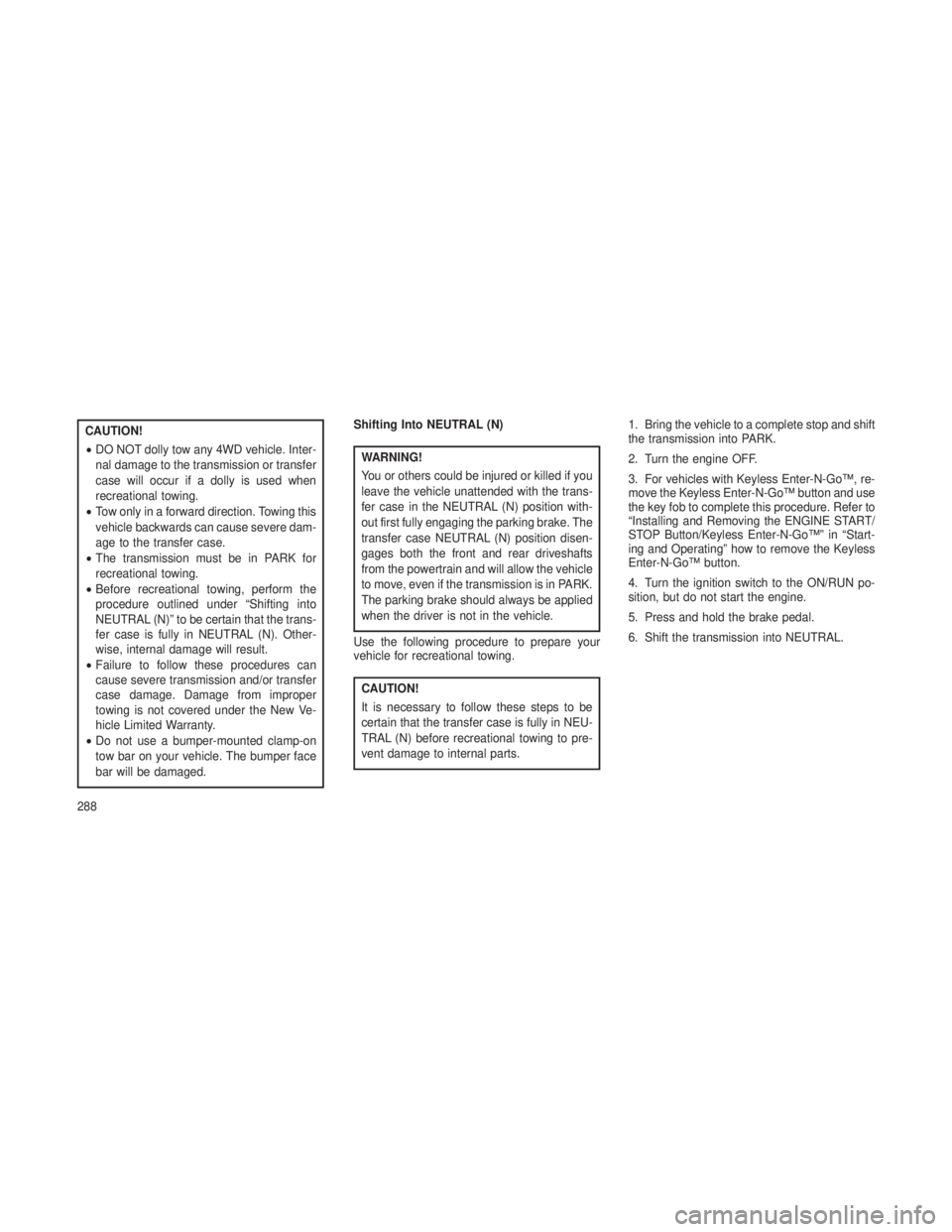
CAUTION!
•DO NOT dolly tow any 4WD vehicle. Inter-
nal damage to the transmission or transfer
case will occur if a dolly is used when
recreational towing.
• Tow only in a forward direction. Towing this
vehicle backwards can cause severe dam-
age to the transfer case.
• The transmission must be in PARK for
recreational towing.
• Before recreational towing, perform the
procedure outlined under “Shifting into
NEUTRAL (N)” to be certain that the trans-
fer case is fully in NEUTRAL (N). Other-
wise, internal damage will result.
• Failure to follow these procedures can
cause severe transmission and/or transfer
case damage. Damage from improper
towing is not covered under the New Ve-
hicle Limited Warranty.
• Do not use a bumper-mounted clamp-on
tow bar on your vehicle. The bumper face
bar will be damaged. Shifting Into NEUTRAL (N)
WARNING!
You or others could be injured or killed if you
leave the vehicle unattended with the trans-
fer case in the NEUTRAL (N) position with-
out first fully engaging the parking brake. The
transfer case NEUTRAL (N) position disen-
gages both the front and rear driveshafts
from the powertrain and will allow the vehicle
to move, even if the transmission is in PARK.
The parking brake should always be applied
when the driver is not in the vehicle.
Use the following procedure to prepare your
vehicle for recreational towing.
CAUTION!
It is necessary to follow these steps to be
certain that the transfer case is fully in NEU-
TRAL (N) before recreational towing to pre-
vent damage to internal parts. 1. Bring the vehicle to a complete stop and shift
the transmission into PARK.
2. Turn the engine OFF.
3. For vehicles with Keyless Enter-N-Go™, re-
move the Keyless Enter-N-Go™ button and use
the key fob to complete this procedure. Refer to
“Installing and Removing the ENGINE START/
STOP Button/Keyless Enter-N-Go™” in “Start-
ing and Operating” how to remove the Keyless
Enter-N-Go™ button.
4. Turn the ignition switch to the ON/RUN po-
sition, but do not start the engine.
5. Press and hold the brake pedal.
6. Shift the transmission into NEUTRAL.
288
Page 293 of 408
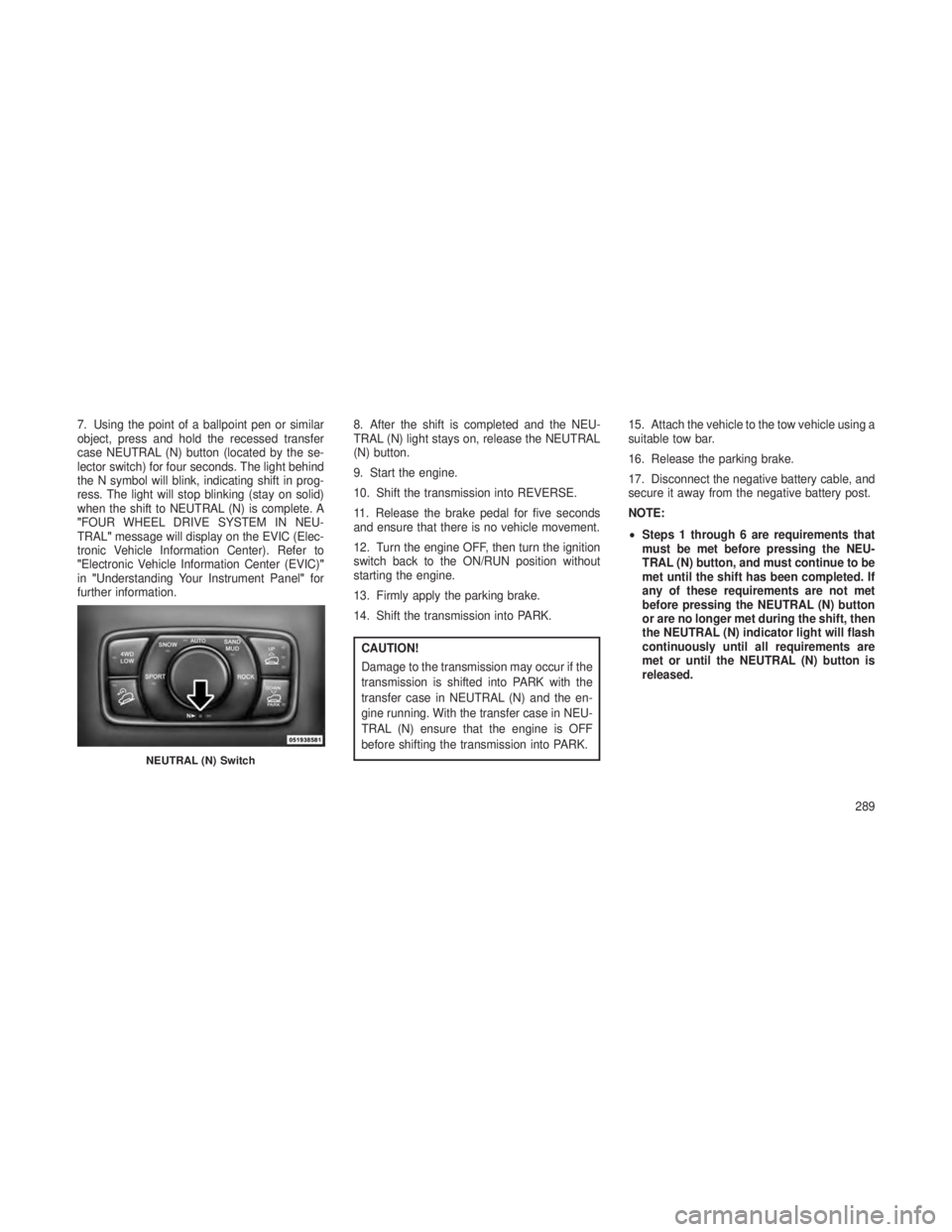
7. Using the point of a ballpoint pen or similar
object, press and hold the recessed transfer
case NEUTRAL (N) button (located by the se-
lector switch) for four seconds. The light behind
the N symbol will blink, indicating shift in prog-
ress. The light will stop blinking (stay on solid)
when the shift to NEUTRAL (N) is complete. A
"FOUR WHEEL DRIVE SYSTEM IN NEU-
TRAL"message will display on the EVIC (Elec-
tronic Vehicle Information Center). Refer to
"Electronic Vehicle Information Center (EVIC)"
in "Understanding Your Instrument Panel "for
further information. 8. After the shift is completed and the NEU-
TRAL (N) light stays on, release the NEUTRAL
(N) button.
9. Start the engine.
10. Shift the transmission into REVERSE.
11. Release the brake pedal for five seconds
and ensure that there is no vehicle movement.
12. Turn the engine OFF, then turn the ignition
switch back to the ON/RUN position without
starting the engine.
13. Firmly apply the parking brake.
14. Shift the transmission into PARK.
CAUTION!
Damage to the transmission may occur if the
transmission is shifted into PARK with the
transfer case in NEUTRAL (N) and the en-
gine running. With the transfer case in NEU-
TRAL (N) ensure that the engine is OFF
before shifting the transmission into PARK.15. Attach the vehicle to the tow vehicle using a
suitable tow bar.
16. Release the parking brake.
17. Disconnect the negative battery cable, and
secure it away from the negative battery post.
NOTE:
•
Steps 1 through 6 are requirements that
must be met before pressing the NEU-
TRAL (N) button, and must continue to be
met until the shift has been completed. If
any of these requirements are not met
before pressing the NEUTRAL (N) button
or are no longer met during the shift, then
the NEUTRAL (N) indicator light will flash
continuously until all requirements are
met or until the NEUTRAL (N) button is
released.
NEUTRAL (N) Switch
289
Page 294 of 408
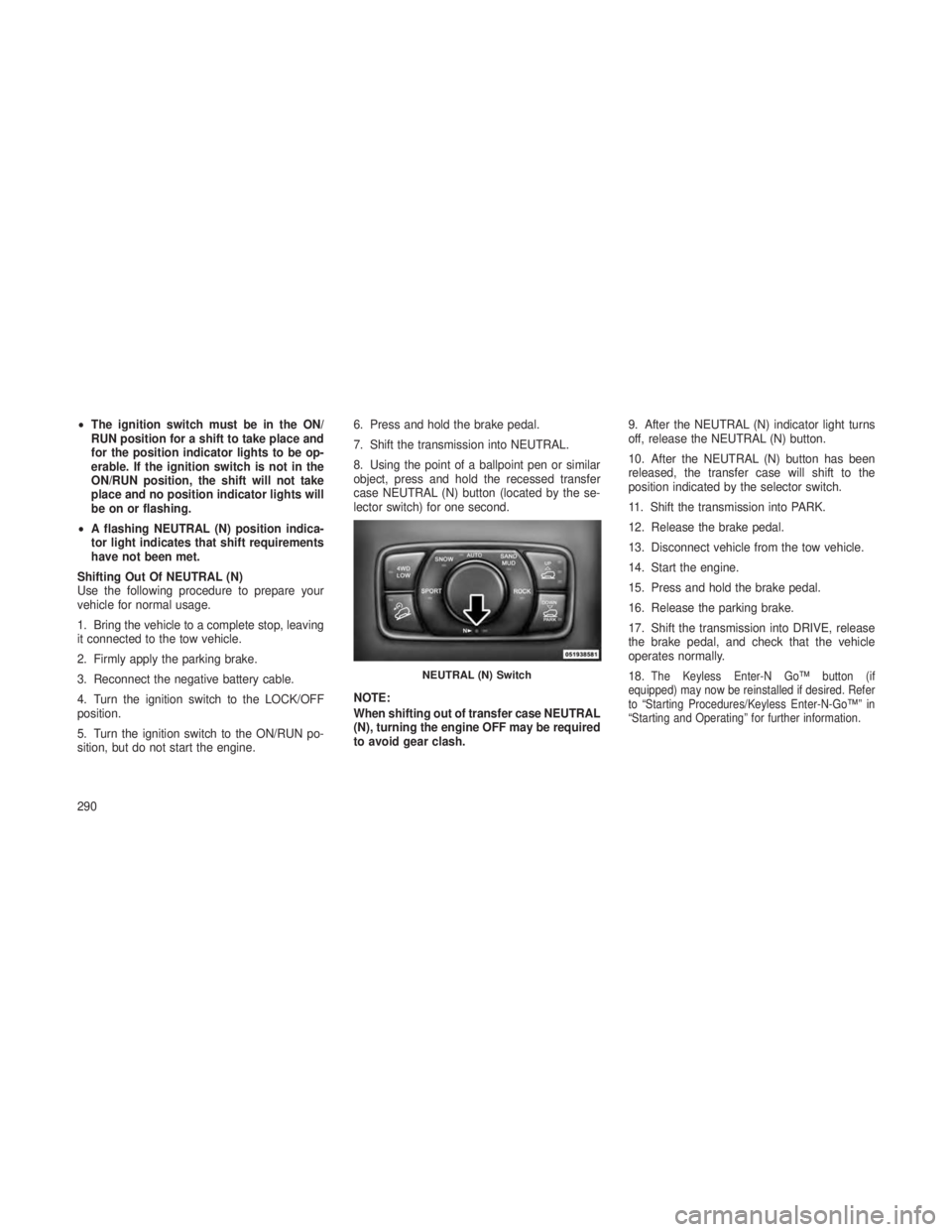
•The ignition switch must be in the ON/
RUN position for a shift to take place and
for the position indicator lights to be op-
erable. If the ignition switch is not in the
ON/RUN position, the shift will not take
place and no position indicator lights will
be on or flashing.
• A flashing NEUTRAL (N) position indica-
tor light indicates that shift requirements
have not been met.
Shifting Out Of NEUTRAL (N)
Use the following procedure to prepare your
vehicle for normal usage.
1. Bring the vehicle to a complete stop, leaving
it connected to the tow vehicle.
2. Firmly apply the parking brake.
3. Reconnect the negative battery cable.
4. Turn the ignition switch to the LOCK/OFF
position.
5. Turn the ignition switch to the ON/RUN po-
sition, but do not start the engine. 6. Press and hold the brake pedal.
7. Shift the transmission into NEUTRAL.
8. Using the point of a ballpoint pen or similar
object, press and hold the recessed transfer
case NEUTRAL (N) button (located by the se-
lector switch) for one second.
NOTE:
When shifting out of transfer case NEUTRAL
(N), turning the engine OFF may be required
to avoid gear clash.
9. After the NEUTRAL (N) indicator light turns
off, release the NEUTRAL (N) button.
10. After the NEUTRAL (N) button has been
released, the transfer case will shift to the
position indicated by the selector switch.
11. Shift the transmission into PARK.
12. Release the brake pedal.
13. Disconnect vehicle from the tow vehicle.
14. Start the engine.
15. Press and hold the brake pedal.
16. Release the parking brake.
17. Shift the transmission into DRIVE, release
the brake pedal, and check that the vehicle
operates normally.
18.
The Keyless Enter-N Go™ button (if
equipped) may now be reinstalled if desired. Refer
to “Starting Procedures/Keyless Enter-N-Go™” in
“Starting and Operating” for further information.NEUTRAL (N) Switch
290
Page 295 of 408
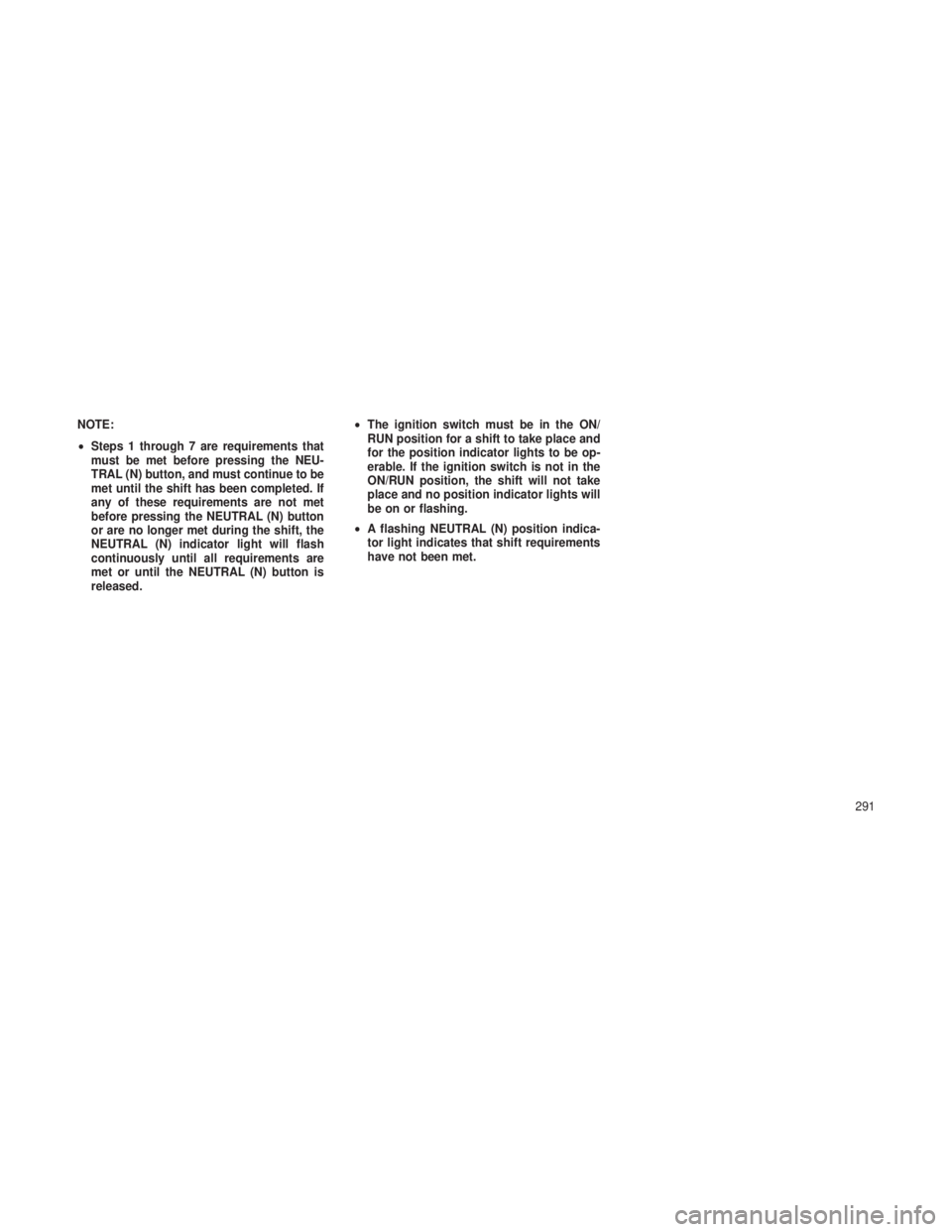
NOTE:
•Steps 1 through 7 are requirements that
must be met before pressing the NEU-
TRAL (N) button, and must continue to be
met until the shift has been completed. If
any of these requirements are not met
before pressing the NEUTRAL (N) button
or are no longer met during the shift, the
NEUTRAL (N) indicator light will flash
continuously until all requirements are
met or until the NEUTRAL (N) button is
released. •
The ignition switch must be in the ON/
RUN position for a shift to take place and
for the position indicator lights to be op-
erable. If the ignition switch is not in the
ON/RUN position, the shift will not take
place and no position indicator lights will
be on or flashing.
• A flashing NEUTRAL (N) position indica-
tor light indicates that shift requirements
have not been met.
291
Page 296 of 408

292
Page 297 of 408
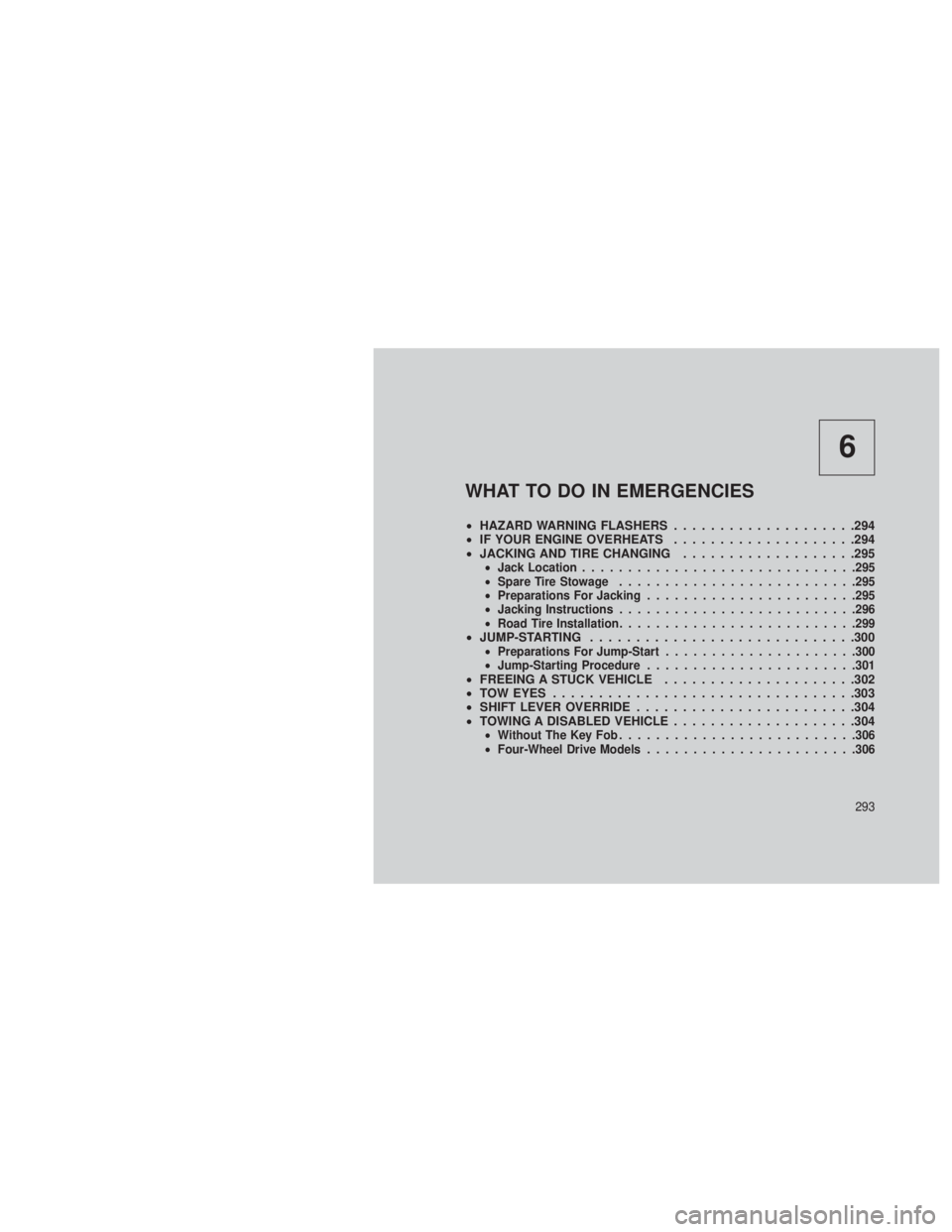
6
WHAT TO DO IN EMERGENCIES
•HAZARD WARNING FLASHERS ....................294
• IF YOUR ENGINE OVERHEATS ....................294
• JACKING AND TIRE CHANGING ...................295
•Jack Location ............................. .295
• Spare Tire Stowage ......................... .295
• Preparations For Jacking ...................... .295
• Jacking Instructions ......................... .296
• Road Tire Installation ......................... .299
•JUMP-STARTING .............................300•Preparations For Jump-Start .................... .300
• Jump-Starting Procedure ...................... .301
•FREEING A STUCK VEHICLE .....................302
• TOW EYES .................................303
• SHIFT LEVER OVERRIDE ........................304
• TOWING A DISABLED VEHICLE ....................304
•Without The Key Fob ......................... .306
• Four-Wheel Drive Models ...................... .306
293
Page 298 of 408
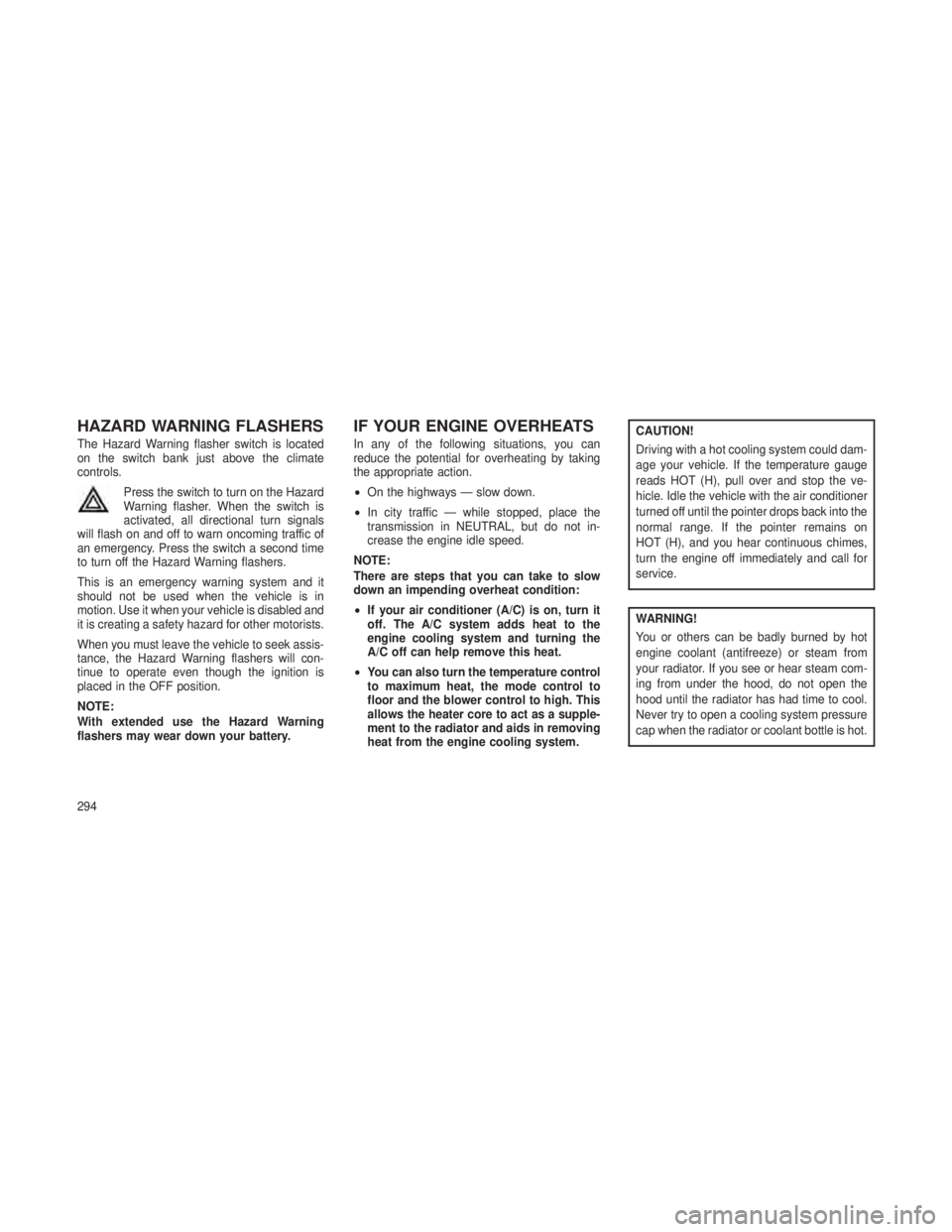
HAZARD WARNING FLASHERS
The Hazard Warning flasher switch is located
on the switch bank just above the climate
controls.Press the switch to turn on the Hazard
Warning flasher. When the switch is
activated, all directional turn signals
will flash on and off to warn oncoming traffic of
an emergency. Press the switch a second time
to turn off the Hazard Warning flashers.
This is an emergency warning system and it
should not be used when the vehicle is in
motion. Use it when your vehicle is disabled and
it is creating a safety hazard for other motorists.
When you must leave the vehicle to seek assis-
tance, the Hazard Warning flashers will con-
tinue to operate even though the ignition is
placed in the OFF position.
NOTE:
With extended use the Hazard Warning
flashers may wear down your battery.
IF YOUR ENGINE OVERHEATS
In any of the following situations, you can
reduce the potential for overheating by taking
the appropriate action.
• On the highways — slow down.
• In city traffic — while stopped, place the
transmission in NEUTRAL, but do not in-
crease the engine idle speed.
NOTE:
There are steps that you can take to slow
down an impending overheat condition:
• If your air conditioner (A/C) is on, turn it
off. The A/C system adds heat to the
engine cooling system and turning the
A/C off can help remove this heat.
• You can also turn the temperature control
to maximum heat, the mode control to
floor and the blower control to high. This
allows the heater core to act as a supple-
ment to the radiator and aids in removing
heat from the engine cooling system.CAUTION!
Driving with a hot cooling system could dam-
age your vehicle. If the temperature gauge
reads HOT (H), pull over and stop the ve-
hicle. Idle the vehicle with the air conditioner
turned off until the pointer drops back into the
normal range. If the pointer remains on
HOT (H), and you hear continuous chimes,
turn the engine off immediately and call for
service.
WARNING!
You or others can be badly burned by hot
engine coolant (antifreeze) or steam from
your radiator. If you see or hear steam com-
ing from under the hood, do not open the
hood until the radiator has had time to cool.
Never try to open a cooling system pressure
cap when the radiator or coolant bottle is hot.
294
Page 299 of 408
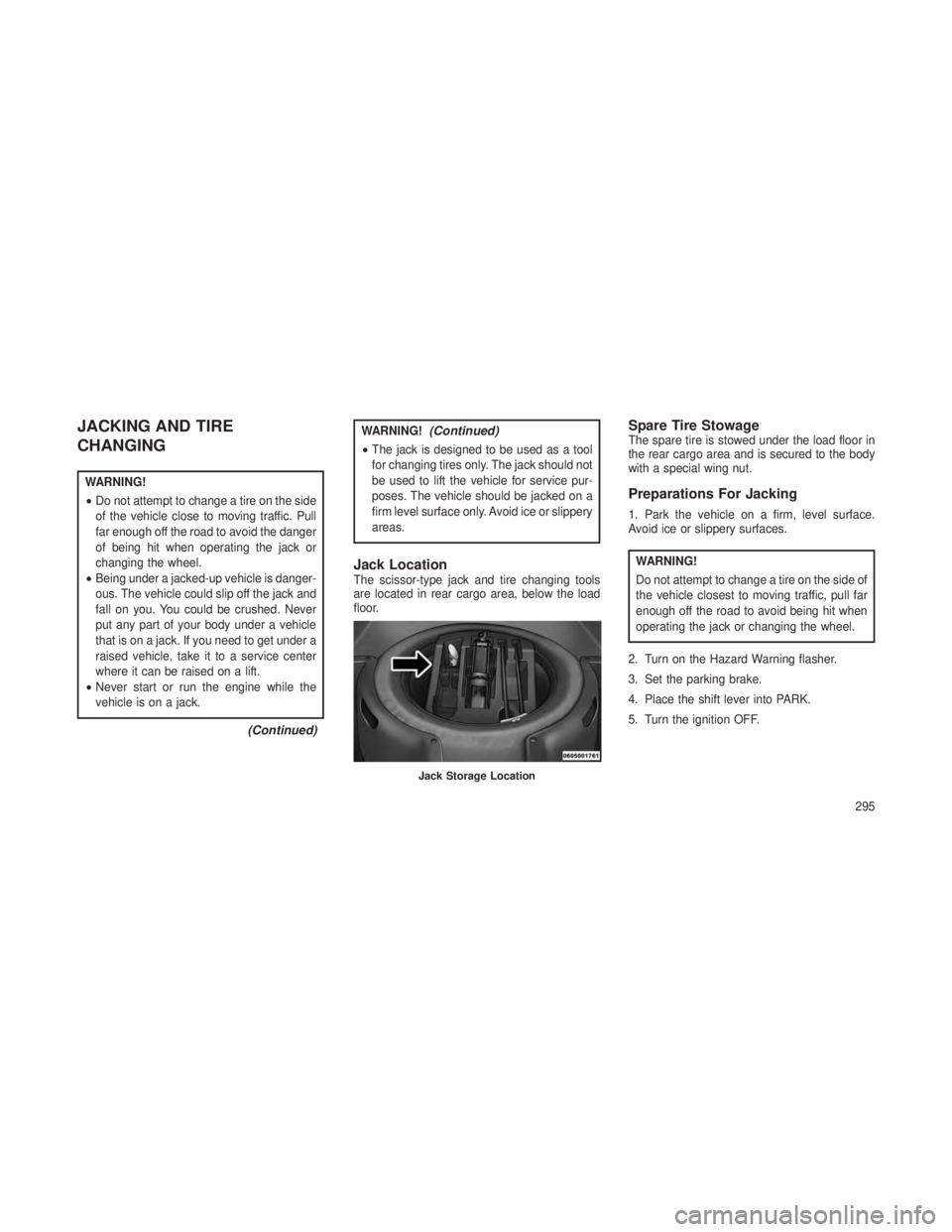
JACKING AND TIRE
CHANGING
WARNING!
•Do not attempt to change a tire on the side
of the vehicle close to moving traffic. Pull
far enough off the road to avoid the danger
of being hit when operating the jack or
changing the wheel.
• Being under a jacked-up vehicle is danger-
ous. The vehicle could slip off the jack and
fall on you. You could be crushed. Never
put any part of your body under a vehicle
that is on a jack. If you need to get under a
raised vehicle, take it to a service center
where it can be raised on a lift.
• Never start or run the engine while the
vehicle is on a jack.
(Continued)
WARNING!(Continued)
•The jack is designed to be used as a tool
for changing tires only. The jack should not
be used to lift the vehicle for service pur-
poses. The vehicle should be jacked on a
firm level surface only. Avoid ice or slippery
areas.
Jack LocationThe scissor-type jack and tire changing tools
are located in rear cargo area, below the load
floor.
Spare Tire StowageThe spare tire is stowed under the load floor in
the rear cargo area and is secured to the body
with a special wing nut.
Preparations For Jacking
1. Park the vehicle on a firm, level surface.
Avoid ice or slippery surfaces.
WARNING!
Do not attempt to change a tire on the side of
the vehicle closest to moving traffic, pull far
enough off the road to avoid being hit when
operating the jack or changing the wheel.
2. Turn on the Hazard Warning flasher.
3. Set the parking brake.
4. Place the shift lever into PARK.
5. Turn the ignition OFF.
Jack Storage Location
295
Page 300 of 408
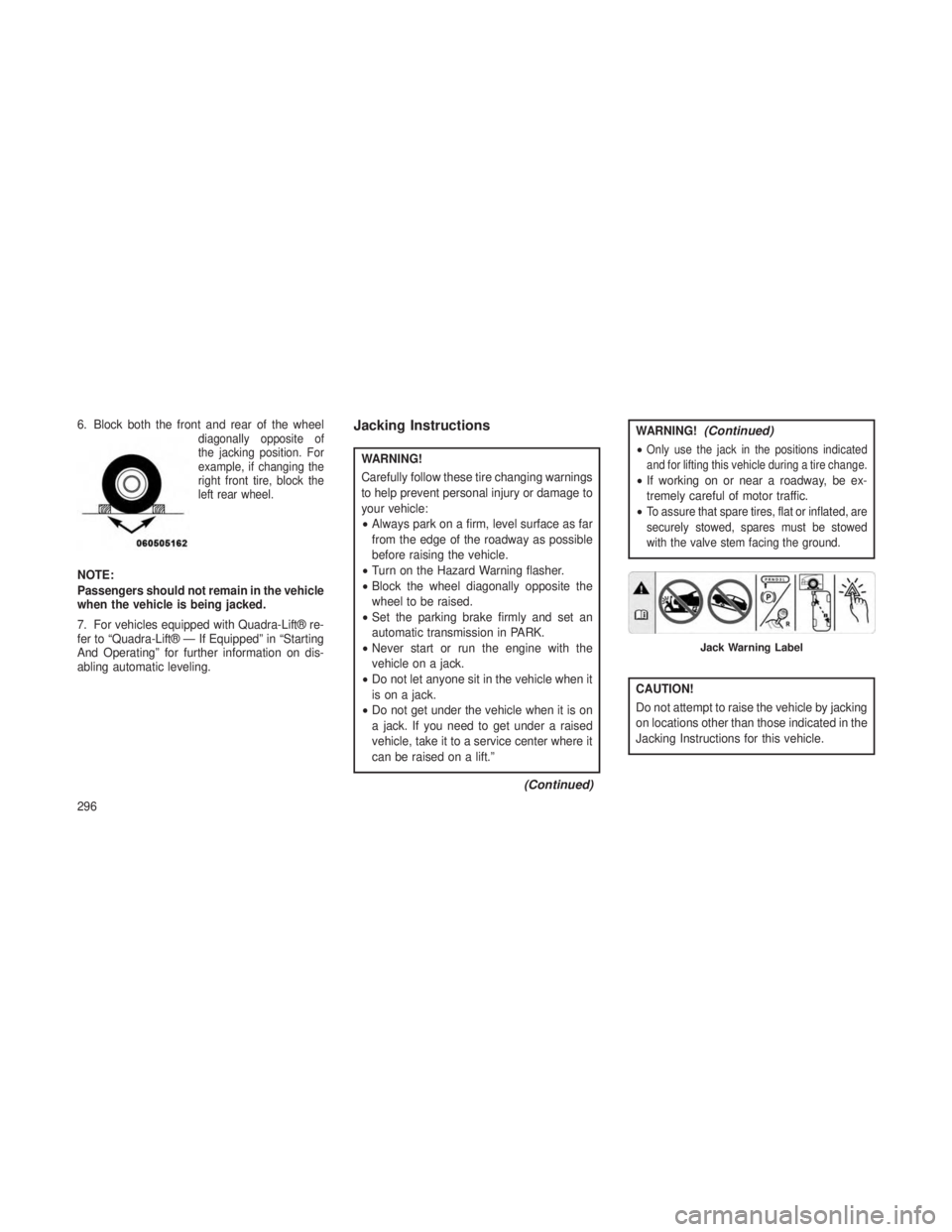
6. Block both the front and rear of the wheeldiagonally opposite of
the jacking position. For
example, if changing the
right front tire, block the
left rear wheel.
NOTE:
Passengers should not remain in the vehicle
when the vehicle is being jacked.
7. For vehicles equipped with Quadra-Lift® re-
fer to “Quadra-Lift® — If Equipped” in “Starting
And Operating” for further information on dis-
abling automatic leveling.
Jacking Instructions
WARNING!
Carefully follow these tire changing warnings
to help prevent personal injury or damage to
your vehicle:
•Always park on a firm, level surface as far
from the edge of the roadway as possible
before raising the vehicle.
• Turn on the Hazard Warning flasher.
• Block the wheel diagonally opposite the
wheel to be raised.
• Set the parking brake firmly and set an
automatic transmission in PARK.
• Never start or run the engine with the
vehicle on a jack.
• Do not let anyone sit in the vehicle when it
is on a jack.
• Do not get under the vehicle when it is on
a jack. If you need to get under a raised
vehicle, take it to a service center where it
can be raised on a lift.”
(Continued)
WARNING!(Continued)
•Only use the jack in the positions indicated
and for lifting this vehicle during a tire change.
•If working on or near a roadway, be ex-
tremely careful of motor traffic.
•
To assure that spare tires, flat or inflated, are
securely stowed, spares must be stowed
with the valve stem facing the ground.
CAUTION!
Do not attempt to raise the vehicle by jacking
on locations other than those indicated in the
Jacking Instructions for this vehicle.
Jack Warning Label
296